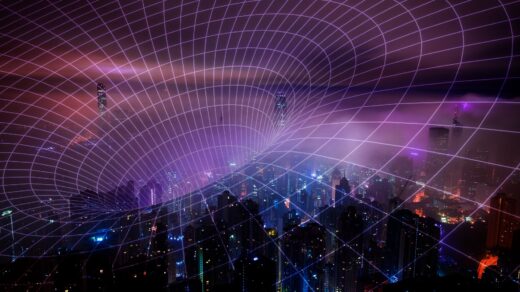VR vs AR: The way we engage with electronic content is changing as a result of two rapidly developing technologies: virtual reality and augmented reality (AR). While they both involve the creation of immersive experiences, their methods, and applications are different.

What is Virtual Reality (VR)?
Virtual reality (VR) is a technology that creates a simulated environment or experience that a user can interact with through the use of specialized equipment such as a headset or gloves. The technique creates a three-dimensional, immersive world that may be felt as though it were real using computer-generated pictures, audio, and other sensory cues.
This makes it possible for users to investigate and engage in natural-feeling interactions with virtual items or settings. Virtual reality has uses in a number of industries, including entertainment, instruction, training, and rehabilitation.
What is Augmented Reality (AR)?
Augmented Reality (AR) is a technology that overlays digital content onto the real world. Through a tool like a smartphone or AR headset, it overlays a layer of digital data or objects onto the user’s perception of the real world. Text, photos, 3D models, and animations are all examples of digital content.
In order to determine the user’s position and orientation in the real world, augmented reality (AR) uses sensors, cameras, and other technology. Then, either on the device’s screen or through a headset, it superimposes digital content onto the user’s view of the outside world.
Difference between AR and VR
Here is a table summarizing the key differences between Augmented Reality (AR) and Virtual Reality (VR):
| Augmented Reality (AR) | Virtual Reality (VR) | |
|---|---|---|
| Level of immersion | Experience that blends real-world and digital material is called semi-immersive. | A fully immersive experience is produced by simulating an environment. |
| Interaction with the real world | Users can still view and engage with the outside world. | Users are removed from the actual world and taken to an entirely other setting. |
| Hardware | Smartphones or AR headsets are examples of devices that can be used to experience AR. | VR needs specialized gear, such as a VR headset. |
| Applications | Industries for increasing in-person encounters include those in retail, advertising, education, and medicine. | For developing immersive experiences, there is gaming, entertainment, education, training, and treatment. |
| Example | The Pokemon Go app places virtual Pokemon over actual surroundings. | A VR game simulating a rollercoaster ride or an outer space exploration |
In conclusion, while augmented reality (AR) and virtual reality (VR), seek to provide immersive experiences, their methods and applications vary. While VR creates a whole simulated surrounding, providing fully immersive knowledge, AR overlays digital media onto the real world to provide a semi-immersive experience. Choosing between the two technologies relies on your expectations and the particular application. Both technologies offer distinctive advantages and uses.

VR vs AR
Components of Virtual Reality (VR)
The main components of Virtual Reality (VR) are:
Head-mounted display (HMD):
A head-mounted device known as an HMD normally has two panels or displays that are positioned in front of the user’s eyes. These displays depict simulations of three-dimensional (3D) environments in the form of graphics or video.
Input devices:
Users can interact with virtual items or situations using VR input devices like controllers or gloves. With the use of these gadgets, users may control items and travel around a virtual world by tracking their hand gestures and motions.
Computer hardware:
In order to generate sophisticated 3D images and deliver a fluid, responsive experience, VR needs strong computer gear. This hardware consists of a powerful processor, graphics card, and memory.
Sensors:
The user’s head motions and location in space are tracked by sensors such as accelerometers, gyroscopes, and cameras. This enables a more immersive experience by enabling the VR system to modify the pictures shown on the HMD based on the user’s motions.
Audio:
Virtual reality must have excellent audio. The audio must be spatially realistic, which requires that sounds seem to originate from specific places inside the virtual world. This contributes to a greater sense of immersion.
Software:
The programs and games that are made to work with VR gear are referred to as VR software. These programs have been specially tailored to offer a fluid and responsive experience in a virtual setting.
Components of Augmented Reality (AR)
The main components of Augmented Reality (AR) are:
Display:
The element that presents the user with both the outside environment and digital material on top is the display. Smartphones or AR headsets, which display the material on a screen, are examples of devices that may be used to enjoy augmented reality.
Sensors:
In order to track the user’s location and orientation in the actual world, sensors like cameras, gyroscopes, and accelerometers are employed. The user’s motions and movements are also picked up by these sensors, enabling interaction with the digital information.
Processor:
Real-time rendering of the digital content onto the display is carried out by the CPU. This calls for a powerful CPU that can handle intricate computations.
Digital content:
Text, photos, 3D models, and animations are all examples of digital content. The user is able to modify and interact with this material, which is superimposed on the physical environment.
Software:
The tools and programs required to build and manage AR experiences are included in AR software. With the use of this software, developers may generate and alter digital material and incorporate it into the physical environment.
Cloud infrastructure:
AR applications can benefit from cloud-based infrastructure’s enhanced speed and flexibility. Cloud services can offer more processing power, storage, analytics, and location-based data.
Conclusion
In conclusion, the technologies of virtual reality (VR) and augmented reality (AR) are revolutionizing how we engage with digital material. While they both involve the creation of immersive experiences, their methods, and applications are different.
While AR superimposes digital content in the real world to create a semi-immersive experience, VR completely simulates the environment to completely immerse users in a three-dimensional (3D) environment. Choosing between the two technologies relies on the desired experience and the individual application because each has a different set of uses and advantages.
More Read
A Complete Details About Computing Power & Quantum Computing
The Rise of Artificial Intelligence in the Healthcare Industry
What is Chat GPT/GPT-4? Is Chat GPT Free or Paid?
Top 15 Highest Paid skills on Fiverr (2023) updated
A List of Currency Converter APIs Free for Developers in 2023


























1 Response
[…] VR vs AR | What are Virtual Reality and Augmented Reality? […]